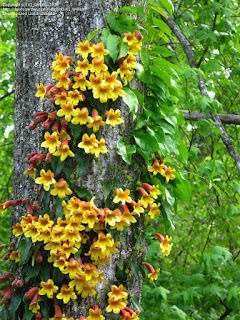Today I had a rare opportunity to participate in a plant rescue, organized by the Southern Piedmont Chapter of the North Carolina Native Plant Society.
A plant rescue is the term used for an organized effort to save plants from destruction by demolition, construction or development of the site where the plants are growing. This particular residence is slated for demolition.
Many rescues take place when highway construction threatens to destroy the habitat where the plants are growing. In this case, the plants were growing in a residential landscape not far from the middle of the city of Charlotte.
Merely blocks away, thousands of people were gathered to watch the Carolina Panthers lose to the Washington Redskins, screaming, yelling, cheering.
The gathering I participated in was much different. Only six people were allowed to take part, and I feel very fortunate to have been included in that small number. Most of us had never met, but we were all there with the purpose of saving these plants, many of which had already been saved years ago from an area that was to be flooded to form Randleman Lake, on the Deep River.
The ground was very moist as a result of the heavy rain that had fallen the previous twenty-four hours. This made it a dirty job, but the rewards were many.
Of the twelve varieties of native plants that were said to be available, I was able to come away with fine specimens of six of those. Some I already have in my garden, so I left those for others.
Our group was a very sharing bunch. I think we all dug plants that were then divided and shared among the rescuers. I don't remember all the names, but I felt at home among them. Plant people are like that.
One of the rules of a plant rescue is that the plants may not be sold. One can plant them in their own garden, share with public gardens or pass along to NCNPS chapters for further distribution.
My six varieties will be added to my personal collection of native plants. If they grow successfully, I hope to be able to propagate from them in numbers that will allow me to list them for sale with the other selections I can offer.
The six varieties I collected today are:
Sanguinaria canadensis, common name of Bloodroot, which is a native perennial plant that grows less than 1 foot tall. It prefers to grow in a shaded area that receives less than two hours of sun a day. The white flowers appear in March and April and can be found throughout the state of North Carolina.
Bignonia capreolata, or Crossvine, is a native perennial woody vine that can grow up to 50 feet in a season. It will grow in sun or part shade. The flowers are yellow and orange and appear in April and May. The vine is most at home in the Piedmont areas of North Carolina.
Asarum canadense, or Wild Ginger, is a perennial native that grows less than one foot tall. It prefers shade to part shade and has brownish blooms in April and May.
Podophyllum peltatum is commonly called Mayapple. It grows from 1 to 3 feet and has white blooms in March and April. It can grow throughout the state.
Polygonatum biflorum is called Solomon's Seal or True Solomon's Seal. It is a shade-loving perennial that will grow up to three feet and blooms are white and green, appearing from April through June. It can be found throughout North Carolina.
Achilllea millefolium or common Yarrow is a plant that I already have in production. The clump I dug was being ignored, so I brought it home with me. The white flowers appear from April into October. It likes full sun and dry soil.
The photos used this week are not my own and I do not claim ownership.
Sunday, December 1, 2019
Subscribe to:
Post Comments (Atom)
Loose Ends
Today is the last day of 2019. It's been a busy week and a half since my last post. One of our sons is in the process of slowly moving...

-
If you are fortunate enough to reside in rural area I would like to say, “How lucky for you!” You, my friend, are among the most fortunate...
-
One wouldn't normally think that there is a connection between growing and gardening with native plants but, surprisingly, there is a ve...
-
Yesterday, as I was exploring the gravel back roads of our little community in the Uwharries, I was excited to run across a stand of native ...












No comments:
Post a Comment